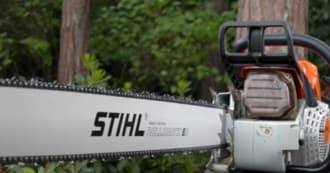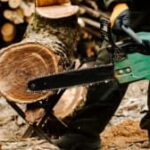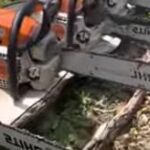As an Amazon Associate, this site earns commissions from qualifying purchases. For more information click here.
Chainsaws are powerful tools used for various tasks, from cutting firewood to trimming trees. However, their sharp blades and high-speed operation pose significant risks to operators. To ensure safety while using a chainsaw, it’s crucial to invest in the right protective gear. This article explores the best chainsaw safety gear to protect yourself during tree cutting activities.
Key Takeaways:
- Chainsaw operators should invest in comprehensive protective gear, including a helmet with face shield and ear protection, chainsaw chaps or pants, and heavy-duty gloves, to safeguard against potential hazards.
- Steel-toe boots and protective eyewear are essential additions to the safety ensemble, providing protection for the feet and eyes from injury and debris.
- Carrying a first aid kit and emergency whistle ensures preparedness to provide immediate medical assistance and signal for help in the event of accidents while using a chainsaw.
Chainsaw Helmet
A chainsaw helmet provides comprehensive protection for your head, face, and ears. Look for a helmet with a built-in face shield to shield your face from flying debris and wood chips. Additionally, ensure it has integrated ear protection, such as earmuffs or earplugs, to reduce noise levels and prevent hearing damage from prolonged exposure to the chainsaw’s loud engine.
Head Protection
The primary function of a chainsaw helmet is to safeguard the head from potential impact injuries caused by falling debris, branches, or accidental contact with the chainsaw. The helmet features a sturdy outer shell made from durable materials such as ABS plastic or fiberglass, designed to absorb and deflect impacts effectively.
Look for helmets with adjustable suspension systems or harnesses to ensure a snug and comfortable fit, providing stability and preventing the helmet from shifting or falling off during use.
Face Shield
A built-in face shield is a critical feature of a chainsaw helmet, offering protection for the face and eyes against flying debris, wood chips, and other hazards encountered during chainsaw operation. The face shield is typically made from impact-resistant materials such as polycarbonate or acrylic, providing a clear and unobstructed view of the work area while deflecting debris away from the face.
Some helmets feature adjustable face shields that can be raised or lowered to accommodate different tasks or preferences, allowing operators to customize their level of protection as needed.
Ear Protection
In addition to head and face protection, chainsaw helmets often include integrated ear protection to safeguard against the harmful effects of noise generated by the chainsaw’s engine. Prolonged exposure to high levels of noise can lead to hearing loss and other auditory issues, making ear protection essential for chainsaw operators. There are also other ways you can reduce chainsaw noise.
Choose helmets with built-in earmuffs or earmuff attachments that provide adequate noise reduction (measured in decibels) to reduce the risk of hearing damage. Alternatively, earplugs made from foam or silicone can be inserted into the ear canal to block out noise effectively.
Chainsaw Chaps
Chainsaw chaps or pants are specially designed to protect your legs from accidental contact with the chainsaw blade. Here’s a detailed exploration of the features and benefits of chainsaw chaps or pants:
Cut-Resistant Materials
Chainsaw chaps or pants are constructed from high-performance materials such as Kevlar, ballistic nylon, or other cut-resistant fabrics. These materials are engineered to withstand the force of a chainsaw blade, effectively reducing the risk of cuts, lacerations, and serious injuries in the event of accidental contact.
The fabric composition of chainsaw chaps or pants is carefully selected to provide optimal protection without compromising comfort or mobility. While offering exceptional cut resistance, these materials remain lightweight, breathable, and flexible, allowing for unrestricted movement during work activities.

Layered Protection
Chainsaw chaps or pants feature multiple layers of cut-resistant fabric strategically arranged to provide maximum protection for vulnerable areas of the legs. The outer layer acts as a shield against the chainsaw blade, while inner layers provide additional reinforcement and energy absorption to minimize the severity of injuries in case of contact.
Some chaps or pants incorporate specialized padding or inserts in critical areas, such as the thighs and calves, to enhance impact resistance and reduce the risk of bruising or trauma from flying debris or tree limbs.
Wraparound Design
The design of chainsaw chaps or pants typically includes a wraparound style that encircles the legs from the waist to the ankles, providing comprehensive coverage and protection for the entire lower body. This design ensures that all areas vulnerable to chainsaw-related injuries are adequately shielded, including the front, sides, and back of the legs.
Adjustable straps or fasteners allow for a customized fit, ensuring that the chaps or pants remain securely in place during movement and work tasks. Proper fit is essential to maximize protection and minimize the risk of chaps slipping or riding up during use.
Industry Standards Compliance
When selecting chainsaw chaps or pants, it’s essential to choose products that meet industry standards for chainsaw protection and safety. Look for chaps or pants that have been tested and certified by recognized organizations, such as ASTM International or the European Committee for Standardization (CEN), to ensure compliance with established safety requirements.
Heavy-Duty Gloves
High-quality, heavy-duty gloves are essential for protecting your hands while operating a chainsaw. Here’s a closer look at the features and benefits of high-quality, heavy-duty glove.
Durable Materials
Heavy-duty gloves are constructed from durable materials that offer resistance to cuts, abrasions, and punctures. Common materials used in the construction of chainsaw gloves include leather, synthetic fibers such as Kevlar or Dyneema, and impact-resistant fabrics like nylon or Cordura.
Leather gloves are renowned for their durability and strength, offering excellent protection against cuts and abrasions. Synthetic fiber gloves, on the other hand, may provide superior cut resistance while remaining lightweight and flexible.
Reinforced Palms and Fingertips
To enhance durability and longevity, heavy-duty gloves feature reinforced palms and fingertips. These areas are subjected to increased wear and tear during chainsaw operation, making them susceptible to cuts and abrasions.
Reinforced palms and fingertips provide an extra layer of protection against sharp edges and rough surfaces, reducing the risk of injuries and extending the lifespan of the gloves.
Secure Grip
Chainsaw gloves should offer a secure grip on the chainsaw handle to ensure precise control and prevent slippage during operation. Look for gloves with textured or patterned surfaces on the palms and fingers to enhance grip in both wet and dry conditions.
Some gloves feature silicone or rubberized coatings on the palms and fingers, providing additional traction and grip on the chainsaw handle. This helps minimize fatigue and hand strain while improving overall safety and productivity.
Cut-Resistant Lining
Many heavy-duty gloves are lined with cut-resistant materials or fibers to provide an added layer of protection against accidental contact with the chainsaw blade. Cut-resistant linings, such as Kevlar or Spectra, offer superior cut protection without sacrificing dexterity or flexibility.
The cut-resistant lining acts as a barrier between the hand and the chainsaw blade, reducing the severity of injuries in the event of a mishap. This added layer of protection enhances safety and peace of mind for chainsaw operators working in challenging environments.
Vibration Dampening
Chainsaw operation can generate significant levels of vibration, which may lead to hand fatigue and discomfort over time. Some heavy-duty gloves feature built-in vibration-dampening padding or gel inserts in the palms and fingers to reduce the impact of vibrations on the hands.
Vibration-dampening gloves help minimize hand fatigue, numbness, and tingling sensations caused by prolonged exposure to chainsaw vibrations. By absorbing and dispersing vibration energy, these gloves enhance comfort and allow operators to work more comfortably for extended periods.
Weather Resistance
Chainsaw gloves should provide protection against various weather conditions, including rain, snow, and cold temperatures. Look for gloves with water-resistant or waterproof coatings to keep hands dry and comfortable in wet environments.
Insulated gloves with thermal lining or fleece interiors offer warmth and protection against cold weather, ensuring hands remain warm and nimble even in freezing temperatures. Weather-resistant gloves enable year-round use and enhance operator comfort and safety in outdoor settings.
Steel-Toe Boots
Steel-toe boots are an indispensable component of chainsaw safety gear, providing vital protection for the feet in hazardous work environments. Here’s an in-depth exploration of their features and benefits:
Toe Protection
Steel-toe boots feature reinforced steel caps in the toe area, offering superior protection against crushing injuries and accidental contact with the chainsaw blade. The steel cap absorbs and deflects impact forces, minimizing the risk of severe foot injuries in the event of falling objects or equipment mishaps.
Puncture-Resistant Soles
The soles of steel-toe boots are constructed from puncture-resistant materials to prevent injuries caused by sharp objects, such as thorns, nails, or debris, penetrating through the sole and into the foot. High-quality boots may incorporate composite materials or multi-layered soles for enhanced puncture protection without compromising flexibility or comfort.
Comfort and Fit
Comfort is paramount when selecting steel-toe boots for chainsaw operation. Choose boots that provide a comfortable fit with ample room in the toe area to prevent pinching or discomfort. Look for features such as cushioned insoles, padded collars, and moisture-wicking linings to enhance comfort during long hours of wear.
Ankle Support and Stability
Steel-toe boots should offer adequate ankle support and stability to reduce the risk of slips, trips, and falls on uneven terrain. Boots with high-top designs or reinforced ankle support structures provide added stability and protection against sprains or twists, enhancing overall safety and confidence while working in challenging environments.
Traction and Grip
The outsoles of steel-toe boots should provide excellent traction and grip on various surfaces, including wet or slippery terrain. Look for boots with aggressive tread patterns and slip-resistant materials to ensure secure footing and minimize the risk of accidents or falls, especially in outdoor or industrial settings.
Durability and Longevity
Invest in high-quality steel-toe boots constructed from durable materials such as full-grain leather, synthetic leather, or waterproof textiles. These materials offer superior durability and resistance to wear, tear, and abrasion, ensuring that the boots remain functional and protective in demanding work environments for an extended period.
Protective Eyewear
Protective eyewear is essential for safeguarding the eyes from potential hazards encountered during chainsaw operation. Let’s delve deeper into the features and benefits of this critical piece of safety gear:
Impact-Resistant Construction
Safety glasses or goggles feature impact-resistant lenses made from polycarbonate or other durable materials to protect against flying debris, wood chips, and dust generated by the chainsaw. The lenses are designed to withstand high-velocity impacts without shattering or breaking, ensuring optimal eye protection in hazardous work environments.
Wraparound Design
Protective eyewear typically features a wraparound design that provides full coverage and prevents debris from entering the eyes from the sides. This design offers maximum protection against airborne particles and ensures clear visibility from all angles, reducing the risk of eye injuries during chainsaw operation.
Anti-Fog Coating and UV Protection
Many safety glasses or goggles are equipped with anti-fog coatings to prevent lens fogging and maintain clear vision in humid or high-moisture environments. Additionally, some eyewear options offer built-in UV protection to shield the eyes from harmful ultraviolet rays emitted by the sun, reducing the risk of eye strain and fatigue in outdoor settings.
Comfortable Fit
Choose safety glasses or goggles that provide a comfortable and secure fit without causing pressure points or discomfort during extended wear. Adjustable nose bridges, flexible temples, and cushioned nose pads enhance comfort and ensure a customized fit for different face shapes and sizes.
Compatibility with Other PPE
Protective eyewear should be compatible with other personal protective equipment (PPE), such as helmets, respirators, and hearing protection devices. Look for eyewear options that can be worn comfortably with other safety gear without compromising fit, seal, or functionality.
Conclusion
Investing in the best chainsaw safety gear is crucial for protecting yourself from potential hazards and injuries while operating a chainsaw. By wearing a chainsaw helmet with face shield and ear protection, chainsaw chaps or pants, heavy-duty gloves, steel-toe boots, protective eyewear, high-visibility clothing, and carrying a first aid kit and emergency whistle, you can minimize the risks associated with chainsaw use and ensure a safe and productive work environment. Remember, safety should always be the top priority when working with chainsaws, and wearing the appropriate protective gear is essential for preventing accidents and injuries.

I love the outdoors and all the tools for maintaining gardens, yards and lawns. The only thing I am more passionate about is sharing what I know about garden and outdoor equipment.


